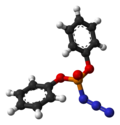Curtius rearrangement
Curtius Rearrangement is a chemical reaction involving the thermal decomposition of an azide to generate an isocyanate, which can further react to form amines, amides, or ureas. This reaction is named after the German chemist Theodor Curtius, who first reported it in 1885. The Curtius Rearrangement is an important reaction in organic chemistry for the synthesis of a wide range of nitrogen-containing compounds.
Mechanism[edit]
The Curtius Rearrangement proceeds through the thermal decomposition of an azide (R-N3) to form an isocyanate (R-NCO). This step involves the loss of nitrogen gas (N2), making the reaction highly exothermic. The generated isocyanate can then undergo various nucleophilic additions depending on the reaction conditions and the nucleophiles present. For example, the reaction with water leads to the formation of a primary amine and carbon dioxide. Alternatively, reaction with an alcohol or amine results in the formation of an urethane or urea, respectively.
Applications[edit]
The versatility of the Curtius Rearrangement has made it a valuable tool in the synthesis of a variety of nitrogen-containing compounds. It is particularly useful in the synthesis of amines, amides, and ureas, which are important in pharmaceuticals, agrochemicals, and polymers. Additionally, the rearrangement has been employed in the synthesis of natural products and complex molecules, demonstrating its utility in both academic and industrial settings.
Variants[edit]
Several variants of the Curtius Rearrangement exist, including the use of different solvents, temperatures, and catalysts to influence the outcome of the reaction. For example, the use of phase transfer catalysts can enhance the reaction rate and selectivity. Moreover, recent advances have explored the use of photochemical and microwave-assisted Curtius Rearrangements, offering more efficient and environmentally friendly alternatives to the traditional thermal methods.
See Also[edit]
References[edit]
<references/>
Curtius rearrangement gallery[edit]
-
Curtius rearrangement reaction
-
DPPA 3D balls
-
Acyl azide formation
-
Curtius rearrangement mechanism concerted
-
Curtius rearrangement photochemical mechanism
-
Curtius rearrangement nitrene insertion
-
Darapsky amino acid synthesis
-
Harger reaction scheme
-
Woodward triquinacene Curtius rearrangement
-
Ishikawa oseltamivir Curtius rearrangement
Ad. Transform your life with W8MD's Budget GLP-1 injections from $75


W8MD offers a medical weight loss program to lose weight in Philadelphia. Our physician-supervised medical weight loss provides:
- Weight loss injections in NYC (generic and brand names):
- Zepbound / Mounjaro, Wegovy / Ozempic, Saxenda
- Most insurances accepted or discounted self-pay rates. We will obtain insurance prior authorizations if needed.
- Generic GLP1 weight loss injections from $75 for the starting dose.
- Also offer prescription weight loss medications including Phentermine, Qsymia, Diethylpropion, Contrave etc.
NYC weight loss doctor appointmentsNYC weight loss doctor appointments
Start your NYC weight loss journey today at our NYC medical weight loss and Philadelphia medical weight loss clinics.
- Call 718-946-5500 to lose weight in NYC or for medical weight loss in Philadelphia 215-676-2334.
- Tags:NYC medical weight loss, Philadelphia lose weight Zepbound NYC, Budget GLP1 weight loss injections, Wegovy Philadelphia, Wegovy NYC, Philadelphia medical weight loss, Brookly weight loss and Wegovy NYC
|
WikiMD's Wellness Encyclopedia |
| Let Food Be Thy Medicine Medicine Thy Food - Hippocrates |
Medical Disclaimer: WikiMD is not a substitute for professional medical advice. The information on WikiMD is provided as an information resource only, may be incorrect, outdated or misleading, and is not to be used or relied on for any diagnostic or treatment purposes. Please consult your health care provider before making any healthcare decisions or for guidance about a specific medical condition. WikiMD expressly disclaims responsibility, and shall have no liability, for any damages, loss, injury, or liability whatsoever suffered as a result of your reliance on the information contained in this site. By visiting this site you agree to the foregoing terms and conditions, which may from time to time be changed or supplemented by WikiMD. If you do not agree to the foregoing terms and conditions, you should not enter or use this site. See full disclaimer.
Credits:Most images are courtesy of Wikimedia commons, and templates, categories Wikipedia, licensed under CC BY SA or similar.
Translate this page: - East Asian
中文,
日本,
한국어,
South Asian
हिन्दी,
தமிழ்,
తెలుగు,
Urdu,
ಕನ್ನಡ,
Southeast Asian
Indonesian,
Vietnamese,
Thai,
မြန်မာဘာသာ,
বাংলা
European
español,
Deutsch,
français,
Greek,
português do Brasil,
polski,
română,
русский,
Nederlands,
norsk,
svenska,
suomi,
Italian
Middle Eastern & African
عربى,
Turkish,
Persian,
Hebrew,
Afrikaans,
isiZulu,
Kiswahili,
Other
Bulgarian,
Hungarian,
Czech,
Swedish,
മലയാളം,
मराठी,
ਪੰਜਾਬੀ,
ગુજરાતી,
Portuguese,
Ukrainian



